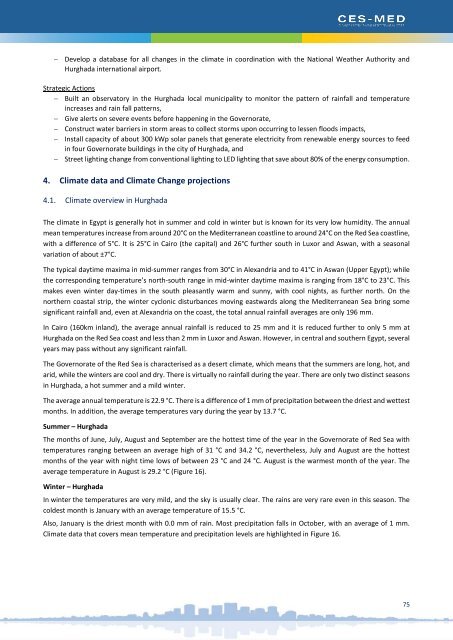020318_Hurghada SECAP_FINAL
You also want an ePaper? Increase the reach of your titles
YUMPU automatically turns print PDFs into web optimized ePapers that Google loves.
− Develop a database for all changes in the climate in coordination with the National Weather Authority and<br />
<strong>Hurghada</strong> international airport.<br />
Strategic Actions<br />
− Built an observatory in the <strong>Hurghada</strong> local municipality to monitor the pattern of rainfall and temperature<br />
increases and rain fall patterns,<br />
− Give alerts on severe events before happening in the Governorate,<br />
− Construct water barriers in storm areas to collect storms upon occurring to lessen floods impacts,<br />
− Install capacity of about 300 kWp solar panels that generate electricity from renewable energy sources to feed<br />
in four Governorate buildings in the city of <strong>Hurghada</strong>, and<br />
− Street lighting change from conventional lighting to LED lighting that save about 80% of the energy consumption.<br />
4. Climate data and Climate Change projections<br />
4.1. Climate overview in <strong>Hurghada</strong><br />
The climate in Egypt is generally hot in summer and cold in winter but is known for its very low humidity. The annual<br />
mean temperatures increase from around 20°C on the Mediterranean coastline to around 24°C on the Red Sea coastline,<br />
with a difference of 5°C. It is 25°C in Cairo (the capital) and 26°C further south in Luxor and Aswan, with a seasonal<br />
variation of about ±7°C.<br />
The typical daytime maxima in mid-summer ranges from 30°C in Alexandria and to 41°C in Aswan (Upper Egypt); while<br />
the corresponding temperature’s north-south range in mid-winter daytime maxima is ranging from 18°C to 23°C. This<br />
makes even winter day-times in the south pleasantly warm and sunny, with cool nights, as further north. On the<br />
northern coastal strip, the winter cyclonic disturbances moving eastwards along the Mediterranean Sea bring some<br />
significant rainfall and, even at Alexandria on the coast, the total annual rainfall averages are only 196 mm.<br />
In Cairo (160km inland), the average annual rainfall is reduced to 25 mm and it is reduced further to only 5 mm at<br />
<strong>Hurghada</strong> on the Red Sea coast and less than 2 mm in Luxor and Aswan. However, in central and southern Egypt, several<br />
years may pass without any significant rainfall.<br />
The Governorate of the Red Sea is characterised as a desert climate, which means that the summers are long, hot, and<br />
arid, while the winters are cool and dry. There is virtually no rainfall during the year. There are only two distinct seasons<br />
in <strong>Hurghada</strong>, a hot summer and a mild winter.<br />
The average annual temperature is 22.9 °C. There is a difference of 1 mm of precipitation between the driest and wettest<br />
months. In addition, the average temperatures vary during the year by 13.7 °C.<br />
Summer – <strong>Hurghada</strong><br />
The months of June, July, August and September are the hottest time of the year in the Governorate of Red Sea with<br />
temperatures ranging between an average high of 31 °C and 34.2 °C, nevertheless, July and August are the hottest<br />
months of the year with night time lows of between 23 °C and 24 °C. August is the warmest month of the year. The<br />
average temperature in August is 29.2 °C (Figure 16).<br />
Winter – <strong>Hurghada</strong><br />
In winter the temperatures are very mild, and the sky is usually clear. The rains are very rare even in this season. The<br />
coldest month is January with an average temperature of 15.5 °C.<br />
Also, January is the driest month with 0.0 mm of rain. Most precipitation falls in October, with an average of 1 mm.<br />
Climate data that covers mean temperature and precipitation levels are highlighted in Figure 16.<br />
75

















